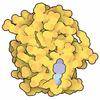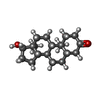+ Open data
Open data
- Basic information
Basic information
| Entry | Database: PDB / ID: 2qpy | ||||||
|---|---|---|---|---|---|---|---|
| Title | AR LBD with small molecule | ||||||
 Components Components |
| ||||||
 Keywords Keywords | DNA BINDING PROTEIN / androgen receptor DHT coactivator / DNA-binding / Lipid-binding / Metal-binding / Nucleus / Steroid-binding / Transcription / Transcription regulation / Ubl conjugation / Zinc / Zinc-finger | ||||||
| Function / homology |  Function and homology information Function and homology informationRUNX2 regulates osteoblast differentiation / negative regulation of integrin biosynthetic process / Activated PKN1 stimulates transcription of AR (androgen receptor) regulated genes KLK2 and KLK3 / SUMOylation of intracellular receptors / Recycling of bile acids and salts / Synthesis of bile acids and bile salts / Nuclear Receptor transcription pathway / Synthesis of bile acids and bile salts via 7alpha-hydroxycholesterol / Synthesis of bile acids and bile salts via 27-hydroxycholesterol / regulation of prostatic bud formation ...RUNX2 regulates osteoblast differentiation / negative regulation of integrin biosynthetic process / Activated PKN1 stimulates transcription of AR (androgen receptor) regulated genes KLK2 and KLK3 / SUMOylation of intracellular receptors / Recycling of bile acids and salts / Synthesis of bile acids and bile salts / Nuclear Receptor transcription pathway / Synthesis of bile acids and bile salts via 7alpha-hydroxycholesterol / Synthesis of bile acids and bile salts via 27-hydroxycholesterol / regulation of prostatic bud formation / HSP90 chaperone cycle for steroid hormone receptors (SHR) in the presence of ligand / Endogenous sterols / HATs acetylate histones / male somatic sex determination / prostate induction / lateral sprouting involved in mammary gland duct morphogenesis / male genitalia morphogenesis / regulation of developmental growth / POU domain binding / positive regulation of integrin biosynthetic process / reproductive structure development / tertiary branching involved in mammary gland duct morphogenesis / Regulation of lipid metabolism by PPARalpha / animal organ formation / Cytoprotection by HMOX1 / androgen binding / Estrogen-dependent gene expression / cellular response to testosterone stimulus / regulation of systemic arterial blood pressure / Leydig cell differentiation / epithelial cell differentiation involved in prostate gland development / positive regulation of epithelial cell proliferation involved in prostate gland development / prostate gland epithelium morphogenesis / prostate gland growth / Ub-specific processing proteases / epithelial cell morphogenesis / membraneless organelle assembly / reproductive system development / fertilization / RNA polymerase II general transcription initiation factor binding / positive regulation of insulin-like growth factor receptor signaling pathway / positive regulation of transcription by RNA polymerase III / RNA polymerase II intronic transcription regulatory region sequence-specific DNA binding / morphogenesis of an epithelial fold / positive regulation of intracellular estrogen receptor signaling pathway / androgen receptor signaling pathway / seminiferous tubule development / locomotor rhythm / aryl hydrocarbon receptor binding / nuclear steroid receptor activity / cellular response to Thyroglobulin triiodothyronine / regulation of lipid metabolic process / regulation of glucose metabolic process / positive regulation of phosphorylation / mammary gland alveolus development / cellular response to estrogen stimulus / single fertilization / RNA polymerase II core promoter sequence-specific DNA binding / regulation of protein localization to plasma membrane / transcription regulator inhibitor activity / intracellular receptor signaling pathway / estrogen receptor signaling pathway / steroid binding / positive regulation of adipose tissue development / peroxisome proliferator activated receptor signaling pathway / regulation of cellular response to insulin stimulus / insulin-like growth factor receptor signaling pathway / response to progesterone / epithelial cell proliferation / nuclear receptor binding / negative regulation of extrinsic apoptotic signaling pathway / negative regulation of smoothened signaling pathway / positive regulation of cell differentiation / circadian regulation of gene expression / mRNA transcription by RNA polymerase II / molecular condensate scaffold activity / circadian rhythm / beta-catenin binding / positive regulation of miRNA transcription / transcription coactivator binding / RNA polymerase II transcription regulator complex / multicellular organism growth / male gonad development / nuclear receptor activity / negative regulation of epithelial cell proliferation / MAPK cascade / ATPase binding / regulation of gene expression / DNA-binding transcription activator activity, RNA polymerase II-specific / spermatogenesis / transcription regulator complex / gene expression / sequence-specific DNA binding / in utero embryonic development / RNA polymerase II-specific DNA-binding transcription factor binding / transcription by RNA polymerase II / transcription coactivator activity / transcription cis-regulatory region binding / positive regulation of MAPK cascade / protein dimerization activity Similarity search - Function | ||||||
| Biological species |  synthetic construct (others) | ||||||
| Method |  X-RAY DIFFRACTION / X-RAY DIFFRACTION /  SYNCHROTRON / SYNCHROTRON /  MOLECULAR REPLACEMENT / Resolution: 2.5 Å MOLECULAR REPLACEMENT / Resolution: 2.5 Å | ||||||
 Authors Authors | Estebanez-Perpina, E. / Fletterick, R. | ||||||
 Citation Citation |  Journal: Proc.Natl.Acad.Sci.Usa / Year: 2007 Journal: Proc.Natl.Acad.Sci.Usa / Year: 2007Title: A surface on the androgen receptor that allosterically regulates coactivator binding. Authors: Estebanez-Perpina, E. / Arnold, L.A. / Arnold, A.A. / Nguyen, P. / Rodrigues, E.D. / Mar, E. / Bateman, R. / Pallai, P. / Shokat, K.M. / Baxter, J.D. / Guy, R.K. / Webb, P. / Fletterick, R.J. | ||||||
| History |
|
- Structure visualization
Structure visualization
| Structure viewer | Molecule:  Molmil Molmil Jmol/JSmol Jmol/JSmol |
|---|
- Downloads & links
Downloads & links
- Download
Download
| PDBx/mmCIF format |  2qpy.cif.gz 2qpy.cif.gz | 65.9 KB | Display |  PDBx/mmCIF format PDBx/mmCIF format |
|---|---|---|---|---|
| PDB format |  pdb2qpy.ent.gz pdb2qpy.ent.gz | 48.4 KB | Display |  PDB format PDB format |
| PDBx/mmJSON format |  2qpy.json.gz 2qpy.json.gz | Tree view |  PDBx/mmJSON format PDBx/mmJSON format | |
| Others |  Other downloads Other downloads |
-Validation report
| Summary document |  2qpy_validation.pdf.gz 2qpy_validation.pdf.gz | 981.8 KB | Display |  wwPDB validaton report wwPDB validaton report |
|---|---|---|---|---|
| Full document |  2qpy_full_validation.pdf.gz 2qpy_full_validation.pdf.gz | 990.7 KB | Display | |
| Data in XML |  2qpy_validation.xml.gz 2qpy_validation.xml.gz | 13.9 KB | Display | |
| Data in CIF |  2qpy_validation.cif.gz 2qpy_validation.cif.gz | 17.6 KB | Display | |
| Arichive directory |  https://data.pdbj.org/pub/pdb/validation_reports/qp/2qpy https://data.pdbj.org/pub/pdb/validation_reports/qp/2qpy ftp://data.pdbj.org/pub/pdb/validation_reports/qp/2qpy ftp://data.pdbj.org/pub/pdb/validation_reports/qp/2qpy | HTTPS FTP |
-Related structure data
| Related structure data |  2pioC  2pipC  2piqC  2pirC  2pitC  2piuC 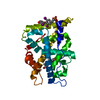 2pivC 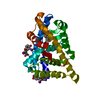 2piwC  2pixC  2pklC C: citing same article ( |
|---|---|
| Similar structure data |
- Links
Links
- Assembly
Assembly
| Deposited unit | 
| ||||||||
|---|---|---|---|---|---|---|---|---|---|
| 1 |
| ||||||||
| Unit cell |
|
- Components
Components
| #1: Protein | Mass: 29277.340 Da / Num. of mol.: 1 Source method: isolated from a genetically manipulated source Source: (gene. exp.)   |
|---|---|
| #2: Protein/peptide | Mass: 1265.457 Da / Num. of mol.: 1 / Source method: obtained synthetically / Source: (synth.) synthetic construct (others) / References: UniProt: Q61026*PLUS |
| #3: Chemical | ChemComp-DHT / |
| #4: Chemical | ChemComp-4HY / [ |
| #5: Water | ChemComp-HOH / |
-Experimental details
-Experiment
| Experiment | Method:  X-RAY DIFFRACTION / Number of used crystals: 1 X-RAY DIFFRACTION / Number of used crystals: 1 |
|---|
- Sample preparation
Sample preparation
| Crystal | Density Matthews: 2.12 Å3/Da / Density % sol: 41.87 % |
|---|---|
| Crystal grow | Method: vapor diffusion, sitting drop / Details: VAPOR DIFFUSION, SITTING DROP |
-Data collection
| Diffraction | Mean temperature: 100 K |
|---|---|
| Diffraction source | Source:  SYNCHROTRON / Site: SYNCHROTRON / Site:  ALS ALS  / Beamline: 8.3.1 / Wavelength: 1.1 Å / Beamline: 8.3.1 / Wavelength: 1.1 Å |
| Detector | Type: ADSC QUANTUM 315 / Detector: CCD / Date: Dec 5, 2006 |
| Radiation | Protocol: SINGLE WAVELENGTH / Monochromatic (M) / Laue (L): M / Scattering type: x-ray |
| Radiation wavelength | Wavelength: 1.1 Å / Relative weight: 1 |
| Reflection | Resolution: 2.5→100 Å / Num. all: 11046 / Num. obs: 9407 / Rmerge(I) obs: 0.093 |
| Reflection shell | Highest resolution: 2.5 Å |
- Processing
Processing
| Software |
| |||||||||||||||
|---|---|---|---|---|---|---|---|---|---|---|---|---|---|---|---|---|
| Refinement | Method to determine structure:  MOLECULAR REPLACEMENT / Resolution: 2.5→100 Å / Stereochemistry target values: Engh & Huber MOLECULAR REPLACEMENT / Resolution: 2.5→100 Å / Stereochemistry target values: Engh & Huber
| |||||||||||||||
| Refinement step | Cycle: LAST / Resolution: 2.5→100 Å
|
 Movie
Movie Controller
Controller



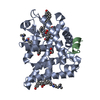
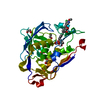


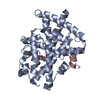
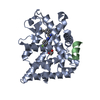




 PDBj
PDBj





